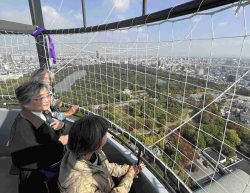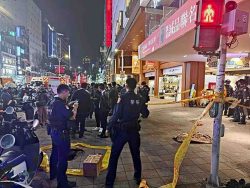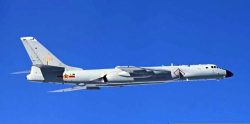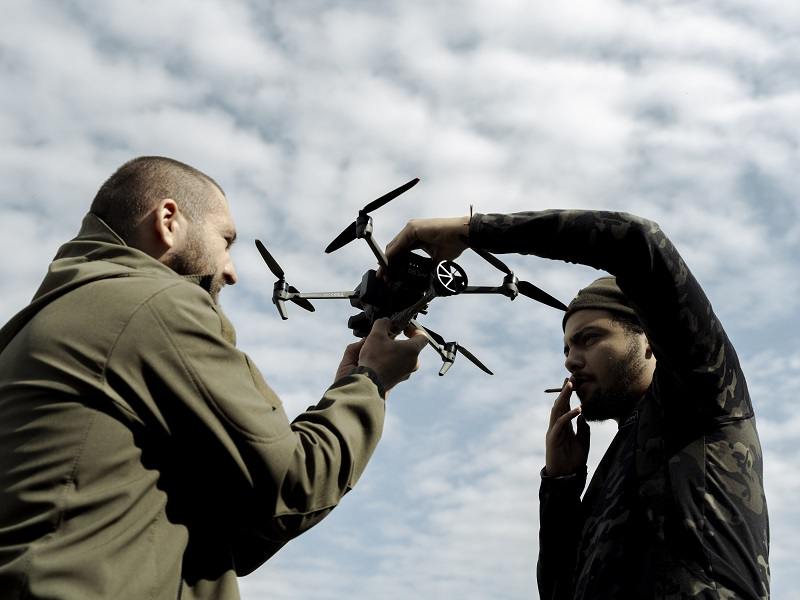
Volunteers learn how to operate a Mavic drone in Ukraine’s Kharkiv region on Sept. 26.
13:09 JST, December 3, 2022
KHARKIV, Ukraine – A war that began with Russian tanks rolling across Ukraine’s borders, World War I-style trenches carved into the earth and Soviet-made artillery pounding the landscape now has a more modern dimension: soldiers observing the battlefield on a small satellite-linked monitor while their palm-size drone hovers out of sight.
With hundreds of reconnaissance and attack drones flying over Ukraine each day, the fight set off by a land grab befitting an 18th-century emperor has transformed into a digital-age competition for technological superiority in the skies – one military annals will mark as a turning point.
In past conflicts, drones were typically used by one side over largely uncontested airspace to locate and hit targets – for example, in U.S. operations in Afghanistan and the Middle East.
In the battle between Russia and Ukraine, drones are integrated into every phase of fighting, with extensive fleets, air defenses and jamming systems on each side. It is a war fought at a distance – the enemy is often miles away – and nothing bridges the gap more than drones, giving Russia and Ukraine the ability to see, and attack, each other without ever getting close.
Ukrainian forces have also used drones to strike targets far from the fighting – in Crimea, which Russia illegally annexed in 2014, and in Russia’s Belgorod border region, according to multiple Ukrainian officials who spoke on the condition of anonymity to discuss sensitive matters but declined to say what type of drones were used. Russia has repeatedly struck Ukraine’s critical civilian infrastructure with self-detonating drones – a cheap substitute for high-precision missiles.
Drones have become so critical to battlefield success that at times they are used to take out other drones.
In early September, just days before Ukraine launched an offensive to expel Russian forces from its northeastern Kharkiv region, a Ukrainian reconnaissance drone flew through a gap between two jamming systems near the Russian border. It crossed into Russia and turned north across the Belgorod region, where Russia bases equipment to support its war in eastern Ukraine.
The drone spotted a base for Moscow’s own unmanned aerial vehicles (UAVs), according to overhead images captured by the Ukrainians that were later reviewed by The Washington Post.
In one frame, a Russian Orlan-10, with a trademark propeller on its nose, could be seen sitting in the field beside a house. Then in an “after” photo, the house had a hole in its roof, and an ambulance could be seen driving up. A Ukrainian attack drone had followed the same route as the reconnaissance drone – and delivered a strike on the fleet of enemy “eyes.”
The attack, which has not been previously reported, dealt a blow to the Russian forces’ ability to see the Ukrainian offensive coming and to counterattack.
Meanwhile, the Ukrainians deployed reconnaissance UAVs to mark the coordinates of Russian command posts, artillery batteries, electronic warfare systems and ammunition depots. Then, as Western-provided multiple-launch rocket systems fired on those targets, drones were flying again, redirecting the rocket fire in real time or confirming that it hit the mark. At times, combat drones delivered the blow themselves.
The Ukrainian strikes weakened the Russians and set the stage for Ukrainian soldiers to advance. When they did, drones were again hovering, allowing the operation’s commander to monitor the troops’ progress on a live stream. “We had the full picture of the fight,” said Col. Gen. Oleksandr Syrsky, commander of the Ukrainian ground forces.
The result was a stunning Russian retreat.
“Two main developments are going to impact future war,” said Samuel Bendett, a military analyst at the Virginia-based research group CNA. “The proliferation and availability of combat drones for longer-ranged, more-sophisticated operations, and the absolute necessity to have cheap tactical drones for close-support operations.”
In Ukraine, that future is now.
– – –
More than anything, drones put eyes on the battlefield. And to see the enemy’s moves, the Ukrainian military last spring created a unit of reconnaissance drone teams called “Ochi” – Ukrainian for “eyes.” Four-person teams are now spread across the eastern front, flying UAVs every day except when it rains.
In September, members of one such team squinted at their small handheld monitor and snickered. On the screen, they could make out several people in military uniform and a cart, in a cornfield across the Oskil River in a part of the Kharkiv region then occupied by Russians.
“They’re stealing the locals’ corn,” said one of the Ukrainian drone operators, who for security reasons spoke on the condition that he be identified by his call sign, “Bars.” A few Russian troops weren’t worth an artillery strike, but the drone would keep watching in case they returned to a base.
Driving an unarmored car, an Ochi team picks a spot near the front line, plugs in backup drone batteries to a generator and fires up a Starlink internet connection, so everything they see can be streamed to nearby brigades.
Their drone, a Matrice 300 quadcopter weighing about eight pounds, and its accompanying parts, including monitors, costs about $40,000 – making it one of the cheapest tools of war.
It is these commercial drones – often small, relatively inexpensive and now ubiquitous – that make the war in Ukraine unique, providing unprecedented visibility and sharpening the accuracy of normally inexact artillery fire.
Military-grade combat drones such as the Turkish-made Bayraktar TB2 used by Ukraine, or the Iranian-made Shahed-136 deployed by Russia, are playing an expanded if more traditional role. But the most popular drone used by each side can fit in your hand – more a bug than a bird.
The small Mavic quadcopter, which like the Matrice 300 is produced by Chinese manufacturer DJI, costs less than $4,000 online. Yuri Baluyevsky, a retired general who served as chief of Russia’s armed forces, called it “a true symbol of modern warfare,” in a book on advanced military strategies published this year.
The use of Mavics is so widespread by each army that Ukrainian soldiers said they often don’t know if the drone they spot is friend or foe. If one hovers for too long rather than just passing by, that’s suspicious enough to warrant shooting it down.
DJI, the largest commercial drone producer in the world, doesn’t formally supply either Ukraine or Russia with Mavics or other UAVs. To distance itself from the war, DJI has suspended sales in Ukraine and Russia. But that doesn’t stop volunteers and charity funds from purchasing in bulk from retailers. The Ukrainians use the drones for reconnaissance but have also rigged them to drop small munitions.
As Ukrainian forces advanced in the southern Kherson region last month, a special forces unit recycled Coke cans into explosives to be dropped from Mavics onto mined fields – a low-cost way of clearing a path for their troops.
A more common use of Mavics, however, is a sort of psychological warfare. In Kharkiv, the volunteer Khartia Battalion uses them to unleash small, cylindrical munitions on Russian bases. The explosives can’t seriously damage a tank but can make the enemy paranoid, fearing a larger attack at any moment.
“We can make their lives a nightmare all of the time,” said Oleksandr Dubinskyi, a Khartia drone pilot.
The Mavic is just one drone in a vast swarm.
There are also EVO II drones, made by Autel Robotics, which like DJI is based in Shenzhen, China. A charity run by Serhiy Prytula, a Ukrainian TV star, has been buying up drones from all over the world – such as the German Vector UAV or the Cypriot Poseidon drone – so that the Ukrainian military can try them.
Senior Ukrainian and Russian commanders, many of whom trained together in Soviet times, used to be skeptical of drones. Now, they are rushing to train thousands of pilots.
Ukraine’s state crowdfunder, United24, has an “Army of Drones” initiative with contracts to buy nearly 1,000 UAVs, said Mykhailo Fedorov, Ukraine’s digital transformation minister. But that’s still not enough.
The goal, Fedorov said, is 10,000 drones flying along the vast front line, to broadcast the fighting without interruption.
In late August, Bars’s Ochi team was transferred to the Kharkiv area, assigned to observe the Russians and identify targets.
Typically, Ochi teams are in constant contact with an artillery unit – providing coordinates of Russian equipment or bases, and monitoring strikes in real time as colleagues carry them out. Ahead of the Kharkiv counteroffensive, the order was to watch and save up targets. Soldiers involved in the lightning push in the northeast said they had never seen so much aerial reconnaissance with such detail.
“The Russians were acting as if this was their home,” said another Ochi operator, who The Post agreed to identify by his call sign, “Felix.” “They were way too comfortable. And they had no idea what was coming.”
On Sept. 6, Ukraine’s Kharkiv counteroffensive kicked off – as did the strikes on targets Ochi had identified, such as ammunition depots and bases. “We were giving them a support picture – where to go or how to get around,” Felix said. “Wherever our guys went, we stayed with them.”
– – –
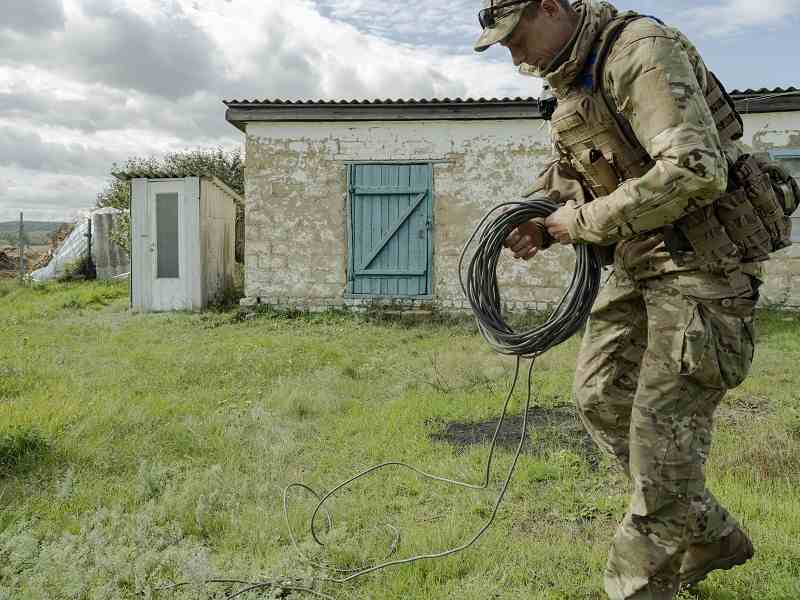
A soldier from Ukraine’s mobile drone unit called Ochi, which means “Eyes.” Ochi teams are now deployed all along the front lines.
Every Ukrainian soldier has had a scary encounter with a Russian Orlan-10 – Russia’s premier reconnaissance drone, which also has electronic-warfare capabilities.
For Lt. Oleksandr Sosovskyy, a deputy battalion commander in Ukraine’s 93rd Mechanized Brigade, his occurred in late April, while traveling with four soldiers to a village near the front line in the Kharkiv region. After parking their car between two houses, he heard an eerie buzzing overhead. They couldn’t see their enemy, but the enemy could see them.
For the next several hours, shelling followed wherever they went. The soldiers tried to split up, moving around the village and ducking for cover. But the Orlan helped the Russians correct their fire. It was relentless and accurate. “They were trying to destroy the car and obviously destroy us,” Sosovskyy said.
In recent months, however, Sosovskyy has noticed there are fewer Orlans to fear. Before, the Russians would often have two flying at once – one for reconnaissance and one to correct artillery strikes. By summertime, hearing or seeing one, much less two, became rarer.
With the use of unmanned aircraft expanding, Ukraine and Russia are trying to ramp up domestic manufacturing of all types of drones. But a noticeable decline in Orlans has highlighted the challenges for Moscow on the production front.
The Orlan-10 is the Russian military’s workhorse in the sky, but it’s unclear how many are left. Many have been shot down, and there is little available data on production rates.
In September, after Russia’s forces were ousted from Kharkiv, Alexander Khodakovsky, commander of Russia’s Vostok Battalion, lamented Moscow’s drone shortage.
“I have fewer people than I would like – but this is not the main difficulty. It’s the fact that for hours I cannot find the positions of the enemy from which they are hitting us,” Khodakovsky wrote on Telegram. “I can’t because there are no means of artillery reconnaissance.”
Col. Yurii Solovey, who heads air defense for Ukraine’s ground forces, said his unit has destroyed more than 580 Orlan-10s since Russia’s invasion began. “They’re starting to use some new drones instead, so that’s a sign to us that they’ve basically run out of the Orlans,” Solovey said. “But they still have to do reconnaissance.”
Alternatives are hard to come by. Russian military systems – especially drones – depend on microelectronic components produced in the United States, Europe and Asia, which Moscow now has difficulty procuring because of sanctions.
Russia’s Defense Ministry has acknowledged the shortfall.
“The Defense Ministry has developed appropriate tactical and technical requirements for unmanned aerial vehicles,” Col. Igor Ischuk told a government panel in September. “Most manufacturers, unfortunately, are not able to fulfill them.”
That gives Ukraine an edge, ramping up production in factories that tend to look like hip offices. Their locations have been wiped from Google Maps – for fear of airstrikes.
Homegrown drones range from miniature planes that can fly nearly 30 miles and drop a five-pound missile – such as the Punisher drone preferred by Ukraine’s special forces – to reconnaissance gliders. The goal is to produce 2,000 small combat drones in Ukraine per month by year’s end, said Fedorov, the digital minister.
Russia’s failures, however, are not just due to lack of hardware. Its experience highlights how drone warfare requires not just advanced equipment but a modern mind-set for decision-making.
Russia’s rigid chain of command requires soldiers on the ground to seek senior approval for strikes, said Pavel Aksenov, a military expert and reporter with the BBC’s Russian service. So even when a Russian reconnaissance drone spots a target, by the time the go-ahead comes through, the target often has moved.
– – –
They heard the threat before they saw it.
As the rumbling drew closer, Ukrainian law enforcement officers in downtown Kyiv steeled themselves and raised their guns skyward, looking for the noise. When they spotted the white triangle through the clouds, they opened fire.
The Iranian-made Shahed drone, with an explosive warhead at its nose, “is a moped in the sky,” moving slowly and loudly before diving into its target, said Solovey, the head of air defense for Ukrainian ground forces.
The Shahed is Russia’s solution to its domestic production woes – a powerful drone bought from another country ostracized by the West. Ukrainian officials said Moscow has recently ordered more from Tehran.
Kyiv and its Western allies say that Russia has bought hundreds of the Shahed-136 drones and that Iranian trainers have traveled to Ukraine to help operate them. The Shaheds debuted in Ukraine on Sept. 20 and initially were used to terrorize southern Ukraine.
The drones have since wreaked havoc all over the country.
When the Kyiv police officers fired their guns into the sky on Oct. 17, one drone was shot down, but four others struck near a power station. One hit a residential building, which split in half and collapsed. Five people were killed.
The Shahed has few metallic parts and flies low, making it difficult to detect. Expensive surface-to-air missile systems, such as an S-300 or Buk, can take them out, but doing so wastes resources that Kyiv would rather use against Moscow’s high-precision missiles. Lately, Ukraine has scrambled fighter jets to shoot down Shaheds.
This frustrating choice is partly the point, said Aksenov, the Russian military expert – to exhaust Kyiv’s resources while conserving Russia’s own arsenal.
Ukraine was the first of the two sides to put foreign drones to use. And one – the Turkish-made Bayraktar TB2 – had a key role in provoking Russian President Vladimir Putin before the invasion.
Kyiv bought its first TB2s in 2019 and used the drones mainly for reconnaissance in its conflict with Russian-led separatist forces in eastern Ukraine. But on Oct. 26, 2021, with the front-line village of Hranitne under heavy shelling, a TB2 carried out its first strike, obliterating an enemy howitzer.
Putin later raised the incident in a phone conversation with Turkish President Recep Tayyip Erdogan, calling Ukraine’s drone use “destructive” behavior and “provocative activity,” according to the Kremlin. In Moscow, the TB2s were used in propaganda about NATO arming Ukraine for attacks on Russia – part of the narrative to justify Putin’s invasion.
The TB2s, which cost about $5 million each, are the most powerful drones in Ukraine’s fleet and offered the first evidence of how UAVs could help Kyiv compete against Russia’s far larger, better-equipped military. The TB2 carries four laser-guided missiles and can fly for more than 24 hours at an altitude of up to 25,000 feet.
Before being used in Ukraine, TB2s featured prominently in conflicts in Libya and Syria, and played a decisive role in Azerbaijan’s victory over Armenia in the 2020 war in Nagorno-Karabakh.
The Ukrainian military said in May that it was using TB2s to attack Russian bases and ships on Snake Island in the Black Sea, from which Moscow’s forces retreated in July.
Ukraine now has several foreign-made combat drones in its fleet, including U.S.-provided Switchblade self-destructing drones. But Bayraktars remain an icon, helping to spur a sort of drone fever in Ukraine.
Recently, volunteers organized a rave in a Kyiv subway station to raise funds to buy a drone. Drone schools have sprouted up across the country, including some specifically for women.
One trainer, Serhii Ristenko, is a photographer who used drone technology to shoot scenes for the hit HBO miniseries “Chernobyl.” When he and his family spent more than a month under Russian occupation in northern Ukraine at the start of the war, he buried his drone in the backyard.
Now Ristenko trains soldiers to fly the R-18 octocopter, made by Ukraine’s Aerorozvidka organization. The drone, equipped with a thermal imager, can fly about six miles when loaded with explosives.
“One of my students was a captain that was more than 50 years old and really wanted to learn to fly,” Restenko said. “I had a feeling he only got a smartphone for the first time in his life the week before we met. He’d call me 50 times a day with questions. But he really wanted to learn, and he actually did it.”
Shortly after the start of the invasion, Syrsky, the colonel general then leading the defense of Kyiv, turned to one of his deputies and suggested making something “artistic” about the Bayraktar to lift public morale. It was inspiring, he said, to watch new technology take out traditional military hardware such as tanks.
The task eventually filtered down to a soldier, Taras Borovok, who quickly wrote the catchy “Bayraktar” tune that became a hit on Ukrainian radio. Among the lyrics: “The Kremlin freak is conducting propaganda; the people swallow the words. Now their czar knows a new word: Bayraktar.”
"News Services" POPULAR ARTICLE
-

American Playwright Jeremy O. Harris Arrested in Japan on Alleged Drug Smuggling
-

Japan’s Nikkei Stock Average as JGB Yields, Yen Rise on Rate-Hike Bets
-

Japan’s Nikkei Stock Average Licks Wounds after Selloff Sparked by BOJ Hike Bets (UPDATE 1)
-

Japanese Bond Yields Zoom, Stocks Slide as Rate Hike Looms
-

Japan’s Nikkei Stock Average Buoyed by Stable Yen; SoftBank’s Slide Caps Gains (UPDATE 1)
JN ACCESS RANKING
-

Keidanren Chairman Yoshinobu Tsutsui Visits Kashiwazaki-Kariwa Nuclear Power Plant; Inspects New Emergency Safety System
-

Imports of Rare Earths from China Facing Delays, May Be Caused by Deterioration of Japan-China Relations
-

University of Tokyo Professor Discusses Japanese Economic Security in Interview Ahead of Forum
-

Japan Pulls out of Vietnam Nuclear Project, Complicating Hanoi’s Power Plans
-

Govt Aims to Expand NISA Program Lineup, Abolish Age Restriction









